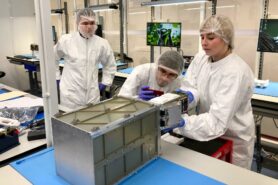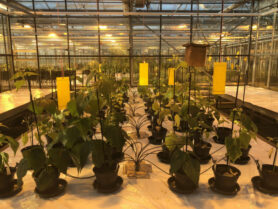Our Life on Mars
Planetary Plants
Imagine that humans manage to make the long journey to Mars. If they then want to stay there for a longer period of time, they will have to grow food there. Preparing a plate of pasta, for example, requires grain, vegetables and perhaps meat. But on Mars, the composition of the soil and air, the temperature, and the gravity are different than on Earth. How different, that is the key question that preoccupies some Mars researchers. How can we grow food on the red planet? We get help from biologist Angelo Vermeulen and technical physicist Charlotte Pouwels.
On Mars, the things we take for granted on Earth are not obvious at all. Take the temperature, for example. It can drop to -140 degrees Celsius there. There is also a lot more cosmic radiation, because Mars has a thin protective atmosphere. In addition, gravity is less than 40% of the gravity on Earth, so you can jump much higher. The composition of the air is also different. For example, the air consists of 95% CO2, a little bit of nitrogen, and you will only find traces of oxygen. So there are quite a few differences.
It is not yet entirely clear what all this has on plants. Space biologist Khaled Kamal and his research group did discover that low gravity causes less cell growth and cell division. This will give you smaller and less strong plants. Plants can get sick from the high radiation, and they will not survive in the cold anyway. Obviously, for both people as plants, none of these are pleasant conditions. In any case, nothing can be grown outdoors on Mars. But where then?
Growth chambers

A possible growth chamber on Mars. Source: nanoracks
So-called growth chambers can be the solution, Vermeulen explains. He is researching how we can live in space, and has also carried out this research in Hawaii in a simulated Mars mission. In these closed growth chambers you can determine all conditions yourself, says Vermeulen. You can then control the temperature, the amount of light, the humidity and the amount of CO2 yourself, and test it thoroughly on earth. This is much safer and more realistic than, for example, using a greenhouse. In a greenhouse you don’t have everything under control yourself (and you would have to wipe it clean from Martian dust every day).
Soil, water and pollination
To grow plants as is we do on earth, at least three things are necessary: nutritious soil, sufficient water, and good pollination. We can’t take that much stuff from Earth though, Pouwels explains. That will be too heavy and too expensive. So we can’t bring bags of potting soil to grow our grain. However, the soil on Mars itself consists of slightly different substances than on Earth. For example, it contains more metals such as lead and mercury. Perchlorate has also been found, which can be quite toxic for humans. And perhaps more importantly, you will find a lot less nitrogen there than in our soil, which is an important nutrient for plants.

Plants on Martian soil. Copyright Wieger Wamelink CC BY-NC 4.0
Since no real Martian soil has yet been taken back to Earth, scientists have to look for something similar here. And how lucky: the soil on volcanoes here in Hawaii is quite similar to the soil found on Mars! This is also used to test whether our plants could grow in Martian soil. Until now, researchers at Wageningen University led by Wieger Wamelink have succeeded in growing beans, potatoes, arugula and tomatoes on the counterfeit Mars soil. The good news: all of this was edible, non-toxic, and (almost) as tasty as on Earth. To fix the nutrient deficiency in the soil, they used what you normally flush down the toilet. You can extract struvite from urine, which is packed with nitrogen (and phosphorus). The dead material from the first generation of plants was also used as a nutrient. These solutions, the researchers think, could also be applied perfectly to Mars itself.
Then step two: the water. Expeditions to find water on Mars are in progress. Italian astronomers think they have already found three saltwater lakes, and ice can be found. With a technique called nanofiltration, this water can be filtered very well, and fresh water can be made from salt and polluted water. Pouwels explains that there is another advantage to this find. Water protects very well against radiation. This water can therefore be used as a kind of insulation layer between the walls, as an extra shield. In this way the radiation problem can largely be solved.
Step three is then pollination. On Earth, we have insects and birds that can pollinate plants, allowing them to produce fruits. How can we do that on Mars? Researchers think that maybe bees could be taken to space. When they are in their hibernation, they can join us in the rocket. If that does not work, people will have to pollinate the plants themselves by hand. This does not have to be a problem at all – this also happens on earth in places where insects are rare.
Hungry for meat?
Finally, if we want to prepare a really luxurious pasta, some meat is needed. That gets a bit more complicated, though. It gets very crowded when pigs and cows also have to come along on the journey. Those animals require an awful lot of energy, soil and nutrients. At the moment, scientists think there are two options. The first is cultured meat. Techniques to “grow” meat yourself in the laboratory, without the need for animals, are now widely tested on earth. A second option is a small change in our diet. Instead of cows, chickens or pigs, we might be better off eating insects. Insects are full of protein and are easier to carry and grow. We’re not used to it yet, but these are nutritious options that we can put to good use in space.
Growing food on Mars looks promising. Vermeulen does admit that the first humans on Mars will probably still depend on the earth to fill their bellies. We know more if Mars soil is taken to our planet to do experiments. The Mars rover, which will land in February 2021, can hopefully help with that. On to our first plate of space pasta!
References
1) Kamal, K.Y., Herranz, R., van Loon, J.J.W.A. et al. Simulated microgravity, Mars gravity, and 2g hypergravity affect cell cycle regulation, ribosome biogenesis, and epigenetics in Arabidopsis cell cultures. Sci Rep 8, 6424 (2018). https://doi.org/10.1038/s41598-018-24942-7
2) Wamelink, G. W. W., Frissel, J. Y., Krijnen, W. H. J., & Verwoert, M. R. (2019). Crop growth and viability of seeds on Mars and Moon soil simulants. Open Agriculture, 4(1), 509–516. doi:10.1515/opag-2019-0051
3) Cannon, K. and Britt, D. T. (2019). Feeding One Million People on Mars. New Space. Vol. 7, Issue 4.http://doi.org/10.1089/space.2019.0018

